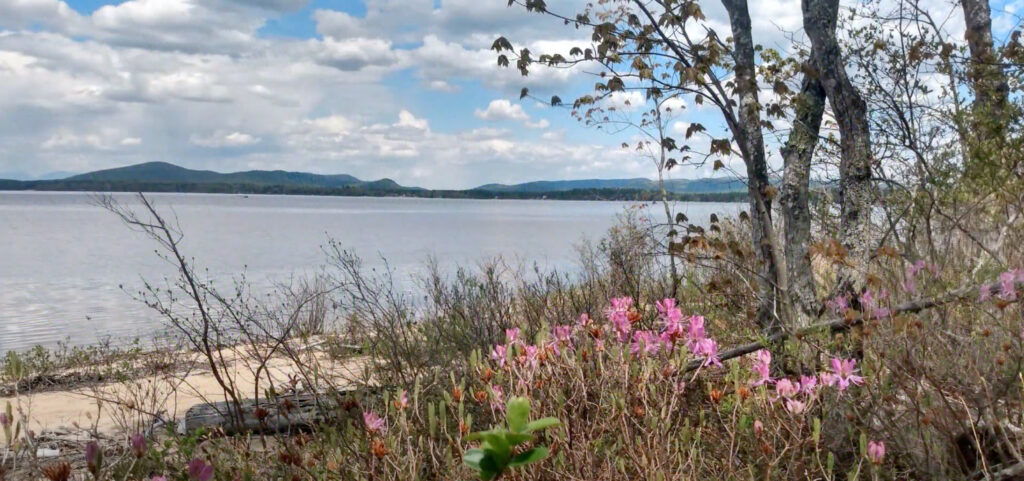From the Archives: A Public Beach in a Natural Area
Part 4: A Transition
“There’s a time to hold ’em and a time to fold ’em, and now is the time to fold ’em,” Harry Merrow told the Ossipee Select Board, channeling Kenny Rogers as he submitted a letter recommending that the town put the beach plan on hold.
It was February, 2006. The beach story had lasted 16 months and cost the town $1,000, more or less. But it had been costly in other ways, pitting resident taxpayers against non-resident taxpayers, and conservation groups against state and local officials.
Ironically, the seeds of the demise of the beach proposal were sown the same month the plan was hatched—November, 2004. As Representative Merrow was announcing he had an agreement with DRED Commissioner O’Kane to lease land in the Natural Area, state voters were ending the tenure of Republican Governor Craig Benson after just two years in office.
Democrat John Lynch took over in January, 2005, and by the end of the year he had decided to replace O’Kane with George Bald—the commissioner whom Benson had replaced with O’Kane. The person who had rejected Ossipee’s previous beach proposal.

Former DRED Commissioner George Bald is credited with mandating that the Natural Area be protected with a management plan to balance recreation and preservation. Contributed Photo
Merrow was gracious in his comments about Bald, saying he had great personal respect for him and thought he was the right man for the job. But he said he had no illusions about the fate of the town’s agreement with DRED. At Ossipee Town Hall the beach plan may have been officially on hold, but everyone knew it was dead.
Bald took office in the spring of 2006, and immediately had Director of Forest and Lands Phil Bryce compile recommendations about the Natural Area. By August, the consensus at the agency was that closing the shoreline was the only way to protect the property until site-specific regulations could be written. Bald agreed, and said the closure would take place before the start of the summer of 2007.
Another Forum
But that didn’t happen. Instead, DRED convened a local forum in the spring, and invited the public to discuss what should be done with the property. Predictably, the meeting was crowded and boisterous, reflecting the rancor that had led up to that point in time. In the end, it produced nothing new.
Lake and conservation groups were left wondering what had just happened. In theory, things were moving in the right direction under Bald. Yet it appeared the Natural Area shoreline might remain open for another summer despite consensus within the agency that doing so would result in further damage.
Green Mountain Conservation Group and Ossipee Lake Alliance privately worried that DRED’s unexplained delay could mean the state would once again try to avoid making a tough decision.
There were similar concerns at the Ossipee and Effingham Conservation Commissions. Relatively muted voices in the debate to that point, they decided it was time to let DRED know what they thought.
Ossipee’s chair Elizabeth Gillette honed-in on DRED’s vague claim that it “couldn’t do much” that summer because of “staff capacity issues” during “a busy time of the season.”

A pre-season shot of Ossipee Lake Natural Area, prior to the arrival of summer boaters. GMCG Video Screen Grab
Making it clear that was unacceptable, she said twice-daily Ranger and Marine Patrol sweeps on busy weekends were the minimum the state needed to do if it wanted to be “taken seriously.”
Effingham’s chair Kamalendu Nath went further. In a letter to DRED’s Phil Bryce, he excoriated the agency for the unexplained delay in closing the shoreline, and called for an easement or joint stewardship arrangement so the property could be turned over to The Nature Conservancy.
“An easement could ensure that the recurring failure and slow bleeding of our natural and cultural heritage comes to an end, once and for all,” he wrote.
Despite the clamor, DRED remained silent. Inside the agency, however, it continued to be clear there was only one path forward. The data had been collected, the public had been given another chance to speak, and the facts were still the facts. It was time to pull the trigger and close the shoreline.
In mid-August the agency did so. With the exception of a small section of the shoreline, the property became off-limits until a management plan could be written and rolled-out the following summer. Park Rangers and Marine Patrol would ensure the closure order was followed.
The decision was logical, empirical and inevitable. But in retrospect, it could not have been easy for Bald to make, given the toxic stew of anger and power politics that had surrounded the issue for decades.
In the end, however, he made good on his 1999 declaration that the Natural Area property deserved to be protected. For the moment, at least, the Natural Area war was over. More good news would follow.
Next: Enter Don Kent.
